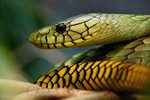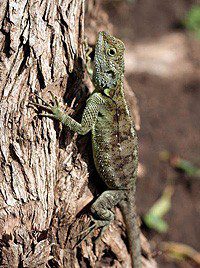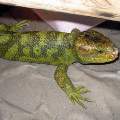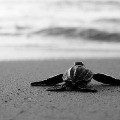
Mamba western
This is perhaps the largest snake among the representatives of the Mamba family. The average length of an adult is 140-210 cm, although sometimes there are individuals that reach three meters in length. She has a long and slender body, a small head, clearly distinct from the neck. The tail makes up about 20-25 percent of the entire body length. Her eyes are of medium size, the pupil is round. The iris is yellow-brown. The color of the green mamba varies from olive green to greenish green, and individuals of a bluish or yellow color are also found. The shields have a black frame.
Contents
Classification
 Kingdom: Animals
Kingdom: Animals
Type: Chord
Subtype: Vertebrates
Class: Reptiles
Order: Scaly
Suborder: Snakes
Family: Asps
Genus: Mambas
Species: Western green mamba Dendroaspis viridis
Inhabitation
As the species name suggests, the western green mamba is native to West Africa. You can meet her on the territory of Ghana, Togo, Nigeria. It lives in tropical forests, giving preference more often to shrubs. Sometimes you can meet the western green mamba and in the city suburbs, parks. The peak of activity of the green mamba falls on the daytime, although sometimes it is activated during the twilight hours.
It lives in the territories of Ghana, Nigeria, Africa and Togo. Prefers the tropical forests of West Africa, especially prone to settling in thickets of shrubs. It can also be found in the city suburbs, parks.
All representatives of the mamba genus are very active, so they will need a large number of different snags and branches; real or artificial plants should be placed in the terrarium. During the daytime, the western green mamba prefers to wrap itself around branches or simply lie on them. Without any problems, this species can be kept in small groups.
Description
 After the black mamba, the western green mamba is the second largest snake of the mamba genus. The average length of an adult is from 1 to 4 m. Specimens reaching 2 meters in length have been recorded. The length of the tail of this snake is approximately 1-3 percent of the entire length of the body. The body itself is long and slender in this species, the head is small and clearly distinct from the neck. The eyes are medium in size, the pupil is round. The iris of the eye is yellow-brown. Most often there are specimens painted in greenish-yellow, olive green, emerald green. Although some individuals may have yellow or bluish hues. Shields are black. The tail is yellow. The skin between the shields is also black. The ventral scutes are pale green, yellow and grey. The tail is yellow with a black border around the scales. This pattern is folded into a kind of grid. Compared to other snakes of the Aspid family, the size of the dorsal shields of the western green mamba is very large. Black leather is visible between the shields. The ventral scutes are yellow, gray and pale green. The middle of the body is surrounded by thirteen shields. The number of ventral scutes varies from 20 to 25. The number of undercaudal scutes varies from 211 to 225 pieces. Inferior labials from 107 to 120, upper labials from 8 to 10. The anal scutellum of the western green mamba is divided.
After the black mamba, the western green mamba is the second largest snake of the mamba genus. The average length of an adult is from 1 to 4 m. Specimens reaching 2 meters in length have been recorded. The length of the tail of this snake is approximately 1-3 percent of the entire length of the body. The body itself is long and slender in this species, the head is small and clearly distinct from the neck. The eyes are medium in size, the pupil is round. The iris of the eye is yellow-brown. Most often there are specimens painted in greenish-yellow, olive green, emerald green. Although some individuals may have yellow or bluish hues. Shields are black. The tail is yellow. The skin between the shields is also black. The ventral scutes are pale green, yellow and grey. The tail is yellow with a black border around the scales. This pattern is folded into a kind of grid. Compared to other snakes of the Aspid family, the size of the dorsal shields of the western green mamba is very large. Black leather is visible between the shields. The ventral scutes are yellow, gray and pale green. The middle of the body is surrounded by thirteen shields. The number of ventral scutes varies from 20 to 25. The number of undercaudal scutes varies from 211 to 225 pieces. Inferior labials from 107 to 120, upper labials from 8 to 10. The anal scutellum of the western green mamba is divided.
As a rule, this snake leads an arboreal lifestyle, climbs trees perfectly. This snake is active, as a rule, during the day, but sometimes it can be active in the dark.
For humans, this species is very dangerous. The venom of the green western mamba is considered even more toxic than that of some varieties of cobras. Most often, the person bitten by this snake simply does not have time to be taken to the hospital. On the upper jaw of the mamba are two poisonous teeth, one on each side. They have grooves that form empty tubes inside. A muscle is located around the poisonous gland. When the snake bites, the muscle presses on the muscle, thus squeezing the poison into the teeth, which follows through the grooves of the teeth into the body of the victim. Most often, the poison paralyzes the victim, acting on her nervous system. When it reaches the nerve centers that control heartbeat and breathing, death occurs.
The standard dimensions of the terrarium are 150 cm long, 70 cm high and 50 cm deep. Coconut substrate mixed with soil can be used as bedding to better retain moisture. It is also permissible to use a cuvette with moss to maintain humidity. Daytime temperature content is from 28 to 32 degrees. In the terrarium, you also need to place a cuvette with water, which the mamba will often use as a pool or drinking water. The snake is very negative about touching its tail, because of this, it can become aggressive and nervous. If she is driven into a corner, then she will often let out her tongue, hiss loudly, although the throw itself is quite rare. In captivity, wild individuals are fed mainly with small rodents, bats, and birds. For adapted mambas, chickens and rodents are suitable. Feeding should be done once a week.
During the breeding season, males fight for the female, which can last several hours. Mating itself takes place both on the branches, when the snakes hang down, and on the ground, the process takes from 10 to 16 hours. After 87-90 days, the female lays eggs. The incubation process lasts for 90-104 days at a temperature of 28 to 30 degrees and a humidity of about 80 percent. Babies are born about 40-45 cm in size. The first feeding occurs after 9-11 days from the moment of birth.
The western green mamba is one of the top 20 most venomous snakes on the planet. For humans, it poses a serious danger. The venom of this snake is considered more toxic than that of some varieties of cobras. Most often, a person who has been bitten by a western green mamba simply does not have time to get to the hospital.
Food
The western green mamba feeds on small mammals, bats, birds and lizards. Feeding in captivity is done once a week. Chickens, small rodents, birds, bats, etc. are suitable for this.
Reproduction
 During the mating season, a fight takes place between the males, which can last for several hours. The mating process itself can last 10-16 hours. Snakes mate both on branches and on the ground. Pregnancy of the female lasts about 3 months. After this period, the female lays eggs. The clutch usually contains 6 to 14 eggs. The incubation period lasts 90-104 days at a temperature of 28 to 30 degrees and a relative humidity of 80 percent. Babies are born about 40-45 cm long. The first molt begins in 9-11 days. Then the first feeding takes place.
During the mating season, a fight takes place between the males, which can last for several hours. The mating process itself can last 10-16 hours. Snakes mate both on branches and on the ground. Pregnancy of the female lasts about 3 months. After this period, the female lays eggs. The clutch usually contains 6 to 14 eggs. The incubation period lasts 90-104 days at a temperature of 28 to 30 degrees and a relative humidity of 80 percent. Babies are born about 40-45 cm long. The first molt begins in 9-11 days. Then the first feeding takes place.
Content
 All representatives of the mamba genus are very active snakes, so they need a large variety of snags and branches. The terrarium will need to be filled with real or artificial plants. During the day, snakes may lie on branches or coil around them. Individuals get along well in groups.
All representatives of the mamba genus are very active snakes, so they need a large variety of snags and branches. The terrarium will need to be filled with real or artificial plants. During the day, snakes may lie on branches or coil around them. Individuals get along well in groups.
For the correct maintenance of the western Siberian mamba, a spacious cubic terrarium is needed, however, as for all snakes of the mamba genus. The standard terrarium size that is suitable for keeping the western green mamba is 150 cm long, 70 cm high and 50 cm deep. Inside the terrarium, it is necessary to place a variety of branches and snags, live or artificial plants. Coconut substrate mixed with earth is used as bedding to maintain optimal humidity. You can also use sphagnum to preserve moisture by placing it in a cuvette. A small pool is required. The average temperature is 28-30 degrees, at night a decrease of 3-5 degrees is required. Good lighting is required. In the terrarium, you will need to place a cuvette with water, which is often used by mamba both as drinking water and as a pool. It is possible to build a shelter, although the snake will rarely use it, the best option is to increase the number of branches in the terrarium (the snake will use them as hiding places). If there is a desire to build a house for snakes, then it is best to make it also from branches.
The snake does not tolerate touching its tail. From this, she can become aggressive and nervous. When cornered, she hisses loudly, often sticking out her tongue. True, the throw itself occurs quite rarely.
Additionally
The western green mamba is one of the top 20 most venomous snakes on the planet.
In processing, the western green mamba is similar to Jameson’s mamba (Dendroaspis jemesoni).
Sources of
http://zmeya.siteedit.ru
http://petland.org.ua
http://spa-kraj.org
http://www.pitomcev.net
Other names
Dendroaspis viridis





